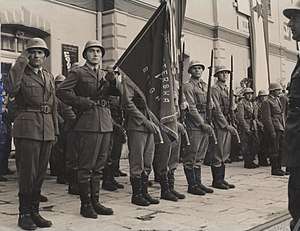Yugoslav People's Army
The Yugoslav People's Army (Serbian: Југословенска народна армија, ЈНА / Jugoslovenska narodna armija, JNA; Croatian: Jugoslavenska narodna armija, JNA; Slovene: Jugoslovanska ljudska armada, JLA; Macedonian: Југословенска народна армија, ЈНА, romanized: Jugoslovenska narodna armija, JNA), also called the Yugoslav National Army,[1][2] was the military of Yugoslavia from 1945 to 1992 and primary part of Yugoslavia armed forces.
| Yugoslav People's Army | |
|---|---|
| Jugoslovenska narodna armija Југословенска народна армија Jugoslavenska narodna armija | |
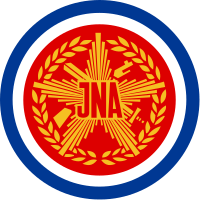 JNA Emblem till 1991 | |
| Founded | 22 December 1941 |
| Disbanded | 20 May 1992 |
| Service branches | Yugoslav Ground Forces (KoV) Yugoslav Navy (JRM) Yugoslav Air Force (JRV) Territorial Defense (TO) |
| Headquarters | Belgrade, Yugoslavia |
| Leadership | |
| Commander-in-Chief | Josip Broz Tito (1945–1980) President of the Presidency of Yugoslavia (1980–1992) |
| Federal Secretary of People's Defence | See list |
| Chief of the General Staff | See list |
| Manpower | |
| Military age | 15–65 |
| Conscription | 18 |
| Available for military service | c. 12,000,000 (1978), age 15–65 |
| Active personnel | Less than 275,341 in 1990. Less than 160,000 in 1991. |
| Reserve personnel | Most of reserve 960,000 in 1990 within territorial defense during war; 783,037 in reserve for YPA in 1990. |
| Related articles | |
| History | History of the JNA |
| Ranks | Yugoslav People's Army ranks |
Origins
The origins of the JNA can be found in the Yugoslav Partisans of World War II. As part of the anti-fascist People's Liberation War of Yugoslavia, the People's Liberation Army of Yugoslavia (NOVJ), a predecessor of the JNA, was formed in the Bosnian town of Rudo on 22 December 1941. After the Yugoslav Partisans liberated the country from the Axis Powers, that date was officially celebrated as the "Day of the Army" in the Socialist Federal Republic of Yugoslavia (SFR Yugoslavia).
In March 1945, the NOVJ was renamed the "Yugoslav Army" ("Jugoslovenska Armija") and, on its 10th anniversary, on 22 December 1951, received the adjective "People's" ("Narodna").[3]
Task and command structure
Under constitution and laws of SFR Yugoslavia, Yugoslav People's Army was part of armed forces together with Territorial Defense (Yugoslavia) as joint armed forces of all people and minority and all working people and citizens of Yugoslavia.
Main task Yugoslav People's Army was that with Territorial Defense (Yugoslavia) as part of armed forces protect independence, sovereignty, territorial integrity and social organization of Socialist Federal Republic of Yugoslavia.[4]
Presidency of Yugoslavia was supreme commander of armed forces and in command of Yugoslav People's Army, Some task from presidency could be given through secretary of defense. Secretary of defense was officer with highest military rank that could command armed forces of Yugoslavia including Yugoslav People's Army and Territorial Defense. While President of Yugoslavia was in function he was under constitution supreme commander of armed forces that includes YPA and TO and he could also pass some of his duties as supreme commander to secretary of defense. They had a power to give highest military ranks such is general or admiral and to promote or relive of duty highest military officers. Secretary of defense was in charge of Yugoslav People's Army. Chief of Staff of Yugoslav People's Army in case that Secretary of defense was prevented or absent to do his function was formally his deputy that can take command of armed forces. In 1987. under decree of Presidency of Yugoslavia, General Staff of YPA was renamed into General Staff of Armed forces of Yugoslavia thus giving effectively command of YPA and TO to one military body in order to effectively command with armed forces in case of war according to law of "All-peoples defense" from 1982.[5][6]
Organization
Structure and organization in late 80's and at beginning of 1990's
In middle 1980s, plans were made under formal top secret strategic and operational plan "Jedinstvo" (eng. unity). Because of internal and external security changes during that time "Jedinstvo" was later modeled in 3 parts "Jedinstvo 1" "Jedinstvo 2" and "Jedinstvo 3" starting from 1987. ( planned in end to be finished in 1995.) for the YPA to start major reform. Plans were mostly modeled to be realized under many covert strategic and operational moves so enemies could not know all and exact changes. During course of time between 1986-1990 major YPA exercise "Romanija" was conducted every year in order to fully reform YPA and get strategic perspective for high military leadership how and what should be done and how it is done. Most of scenarios in exercise included defense from NATO invasion including Albania and Austria with last exercise from series "Romanija 90" was done during 1990. with task of performing offensive at end of war scenario while units were reformed.
A first part of YPA major overhaul under "Jedinstvo 1" had its basic force structure nearly completed in 1989. Manpower was planned to be reduced to about 1 million in war time while in peace time it would be 299.057 personnel including officers, soldiers and civilians that worked in army. Equipment purchase was not realized in full.
The JNA organization and structure after "Jedinstvo 1" consisted of the Ground Forces, Air Force and Navy. Under reforms through "Jedinstvo" plan it was planned to reorganize from army's structure into four major army area called "Vojna oblast" under command of SSNO(equivalent of General Staff) - "Vojna oblast" or military regions were further divided into corps, garrisons and smaller districts and sectors that were responsible for administrative tasks such as draft registration, mobilization, and construction and maintenance of military facilities. The regions were:
- First military region with headquarters in Belgrade (responsible for eastern Croatia, northern and central parts of Serbia and parts of Bosnia and Herzegovina)
- Second military region with headquarters in Zagreb (Slovenia and northern Croatia)
- Third military region with headquarters in Skopje (Macedonia, Southern Serbia and Montenegro)
- Military-naval region "Vojnopomorska oblast" with headquarters in Split. Military-Naval Region included parts of Croatia, Bosnia and Herzegovina and Montenegro - almost all Yugoslavia coastline. It had subdivision on three sectors including flotilla and one corps.
Directly under SSNO were Guards motorized brigade, school centers, 3 SIGNAL regiments. light anti-aircraft artillery regiment and a few independent battalions and divisions.
In "Jedinstvo 1" reforms YPA eliminated most of its old divisional infantry organization and established the brigade and corps structure with some independent units under direct command of SSNO(equivalent of General Staff). Territorial defense also changed and laws and constitution was amended to address those changes. The Ground Forces converted ten of twelve infantry divisions into twenty-nine tank, mechanized and mountain infantry brigades with integral artillery, air defense and anti-tank regiments under corps structure. One airborne brigade was organized before 1990. The shift to brigade-level organization provided greater operational flexibility, maneuverability, tactical initiative and reduced the possibility that large army units would be destroyed in set piece engagements with an aggressor. The change created many senior field command positions that would develop relatively young and talented officers. In 1989. five independent divisions under general staff command and 25 partisans divisions under corps command were formed including many other battalions, regiments and batteries under different commands.
In 1989. plan "Jedinstvo 2" has started and border battalions were transferred under corps command including some divisions that have remained before under others commands. Brigades got some artillery and antiaircraft batteries under their direct command that helped them to gain more independence in war time from higher levels. Defense of all major cities was until then planned with separate units but under "Jedinstvo 2" only Belgrade and Zagreb retained separated units for defense of cities - command for defense of city of Belgrade and command for defense of city of Zagreb.
There were usually three classes of brigades, regiments and battalions:
- A. class
- B. class and
- R. class.
A. class brigades and battalions were more than 60 to up to 100% manned, B. class units had 15-60% manpower. R. class units where reserve with about 15-20% and was manned mostly in their logistic units and commands. Battalions with A. class status were 100% manned and equipped. A. class brigade had 4 battalions and B class brigade had 2-3 battalions.
"Jedinstvo 3" plan started in 1990. when for military leadership of YPA was obvious that USSR was moving to defense of its internal borders and only superpower left to contest all world was USA. It was then agreed in YPA that potential for aggression from Warsaw Pact has diminished but potential aggression from NATO has increased. According to new world global order new plan "Jedinstvo 3" included this changes to organize better defenses from new perceived external threats. Plan required building of smaller but more modernized forces with highly mobile units. Corps close to border would have 2 brigades of A. class including artillery regiment of A. class, anti-armor regiment of B. class and engineering battalion of A class, while corps deeper inside country would have 1 brigade of A. or B. class. Under "Jedinstvo 3" every corps in Air Force should have one support aviation brigade, one fighter wing, one Air Surveillance, Early Warning and Guidance regiment, 1-2 rocket brigade or regiment and rest up to possibilities to equip.[7]
Under "Jedinstvo 2" YPA on 1. January 1990. had:[8]
- 5 divisions - 2 R. and 3 B. class
- 23 partisans divisions of R. class
- 72 partisans brigade of R. class
- 20 infantry brigades - 2 A., 10 B. and 8 R. class
- 17 infantry regiments - 5 B. 12. R. class
- 7 hill brigades - 3 B. 4 R. class
- 1 mountain brigade B. class
- 32 motorized brigades - 4 A., 21 B. and 7. R. class
- 2 marines infantries brigades B. class
- 1 Guard motorized brigade A. class
- 6 Armor brigades of B. class
- 11 Mechanized brigades - 7. A. class, 3. B. class and 1 R. class
- 1 artillery rocket brigade B. class
- 6 mixed artillery brigades B. class
- 5 mixed anti-armor artillery brigades B. class
and many others battalions, regiments, including 19 military police battalions and river flotilla giving in total 28 divisions, 307 brigades and regiments and 137 independent battalions/divisions. Total of 407 units in three different class. Total in manpower 275.341 in peace and 1.058.378 in war.
Under "Jedinstvo 3" until 1995. structure of YPA should be:[9]
- 1 Mechanized division A. class
- 18 Partisans divisions of R. class
- 7. Motorized brigades of R.class
- 39 motorized brigades - 7 A. class
- 17 mechanized brigade - 15 A. and 2 R. class
and many other units giving smaller but more modern and mobile forces with more mobile A. class units with total 19. divisions, 234. brigades and 104 independent battalions/regiments in 1995. Total in manpower at end of 1995. should be 222.151 in peace and 834.891 in war.
Internal changes in Yugoslavia prevented total realization of "Jedinstvo 3" plan. While many changes under "Jedinstvo 3" plan were taken during 1990. according to plan not all were done completely. While most of commands and units were formed and manned equipping was not finished according to plan because of dissolution of Yugoslavia and stopping of deliveries from most of domestic factories to units of YPA.
As part of armed forces there was also Territorial Defense (Yugoslavia) based on each republic's territory that formed Yugoslavia under command of YPA during wartime.
Ground forces
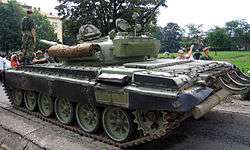
The ground forces had the greatest number of personnel. In 1991 there were about 140,000 active-duty soldiers (including 90,000 conscripts), and over a million trained reservists could be mobilized in wartime. Each of the Yugoslav constituent republics had its own Territorial Defence forces which in wartime were subordinate to supreme command as an integral part of the defence system. The territorial defence (reserve force) was made up of former conscripts; they were occasionally called up for war exercises.
The ground forces were organised into infantry, armour, artillery, and air defence, as well as signal, engineering and chemical defence corps.
Air force
The Yugoslav Air Force had about 32,000 personnel including 4,000 conscripts, and operated over 400 aircraft and 200 helicopters. It was responsible for transport, reconnaissance, and rotary-wing aircraft as well as the national air defence system. The primary air force missions were to contest enemy efforts to establish air supremacy over Yugoslavia and to support the defensive operations of the ground forces and navy. Most aircraft were produced in Yugoslavia. Missiles were produced domestically and supplied by the Soviet Union.
The Yugoslav Air Force had twelve squadrons of domestically produced ground attack fighters. The ground attack squadrons provided close air support to ground force operations. They were equipped with 165 new Soko J-22 Orao, Super Galeb and J-21 Jastreb, and older Soko J-20 Kraguj fighters. Many ground attack fighters were armed with AGM-65 Maverick air-to-surface missiles purchased from the United States. Others were armed with Soviet Kh-23 and Kh-28 missiles. The air force also had about ninety armed Mi-8 helicopter gunships to provide added mobility and fire support for small ground units. A large number of reconnaissance aircraft were available to support ground forces operations. Four squadrons of seventy Galeb, Jastreb, and Orao-1 fighters were configured for reconnaissance missions.
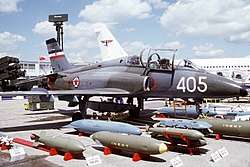
The Yugoslav Air Force had nine squadrons of 130 Soviet-made MiG-21 interceptors for air defence. First produced in the late 1950s, the MiG-21 design was largely obsolete in 1990 and represented a potential weakness in Yugoslavia's air defence. However, the bulk of the MiG-21 fleet consisted mainly of the bis variant, the latest production MiG-21 model, and was armed with Soviet Vympel K-13 (NATO reporting name: AA-2 "Atoll"), air-to-air missiles and some more modern Molniya R-60 (NATO reporting name: AA-8 "Aphid") missiles as well as twin 23 mm cannons. By 1989, Yugoslavia started developing a new domestic multirole fighter called Novi Avion, which was supposed to replace the MiG-21 and J-21 Jastreb fleets entirely. The design of the new aircraft was influenced by both Mirage 2000 and Dassault Rafale fighter types and it was to enter service by the early 2000s. As an interim solution, a modernization package was planned for the MiG-21 and it is speculated that India's MiG-21 Bison upgrade was actually intended for Yugoslav aircraft. In 1987, Yugoslavia acquired 16 MiG-29s.
Although not officially known at the time, Yugoslavia was rumoured to have been interested in the purchase of certain numbers of Su-25 attack-aircraft and Mi-24 gunships. Instead of developing its own fighter plane, the Novi Avion, the country made a request to licence-build the F-20, but due to unstable relations with the US, the request was rejected. By the late 1980s, the licensed production of Aérospatiale SA 330 Puma helicopters was also envisaged, but due to the dissolution of the country, it was never realized.
One of the most impressive structures operated by the JNA Air Force was the underground Željava Air Base near the town of Bihać in NW Bosnia-Herzegovina. The structure was made to withstand a nuclear explosion and was destroyed by the JNA in 1992 to prevent its capture. Željava was home to the 117th Fighter Aviation Regiment, which was composed of the 124th and 125th Fighter Squadrons, equipped with MiG-21Bis fighters, and the 352nd Reconnaissance Squadron, equipped with MiG-21R aircraft.
The Air and Air Defence Forces were headquartered at Zemun and had fighter and bomber aircraft, helicopters, and air defence artillery units at air bases throughout the former Yugoslavia: Batajnica Air Base (Belgrade), Niš Constantine the Great Airport, Slatina Air Base (Priština), Golubovci Airbase (Titograd), Skopski Petrovec, Sarajevo, Mostar, Željava Air Base (Bihać), Pleso (Zagreb), Split Airport, Pula, Zemunik (Zadar), Cerklje ob Krki and many other smaller air bases.
Navy
Minor surface combatants operated by the Yugoslav Navy included nearly eighty frigates, corvettes, submarines, minesweepers, and missile, torpedo, and patrol boats in the Adriatic Fleet. The entire coast of Yugoslavia was part of the naval region headquartered at Split, Croatia.
The Partisans had operated many small boats in raids harassing Italian convoys in the Adriatic Sea during World War II. After the war, the navy operated numerous German and Italian submarines, destroyers, minesweepers, and tank-landing craft captured during the war or received as war reparations. The United States provided eight torpedo boats in the late 1940s, but most of those units were soon obsolete. The navy was upgraded in the 1960s when it acquired ten Osa-I class missile boats and four Shershen class torpedo boats from the Soviet Union. The Soviets granted a license to build eleven additional Shershen units in Yugoslav shipyards developed for this purpose.
In 1980 and 1982, the Yugoslav navy took delivery of two Soviet Koni class frigates. In 1988 it completed two additional units under license. The Koni frigates were armed with four Soviet P-15 Termit surface-to-surface missile launchers, twin 9K33 Osa (NATO reporting name: SA-8 "Gecko") surface-to-air missiles, and anti-submarine rocket launchers.
The Yugoslav navy developed its own submarine-building capability during the 1960s. In 1990, the main combat units of the submarine service were three Heroj class submarines armed with 533 mm torpedoes. Two smaller Sava class submarines entered service in the late 1970s. Two Sutjeska-class submarines had been relegated mainly to training missions by 1990. At that time the navy had apparently shifted to construction of versatile midget submarines. Four Una-class midgets and four Mala-class swimmer delivery vehicles were in service in the late 1980s. They were built for use by underwater demolition teams and special forces. The Una-class boats carried five crewmen, eight combat swimmers, four Mala vehicles, and limpet mines. The Mala vehicles carried two swimmers and 250 kilograms of mines.
The Yugoslav navy operated ten Osa class missile boats and six Končar class missile boats. The Osa I boats were armed with four P-15 Termit surface-to-surface missile launchers. In 1990, ten domestic Kobra missile boats were scheduled to begin replacing the Osa I class. The Kobra class was to be armed with eight Swedish RBS-15 anti-ship missiles, and fifteen of them were ordered in late 1989. Armed with two P-15 Termit launchers, the Končar class boats were modeled after the Spica class torpedo boats, and there were plans to upgrade them with Swedish-built missiles. Two Kobra missile boats were built by Croatia as the Kralj-class fast attack craft and both are still in service. The navy's fifteen Topčider-class torpedo boats included four former Soviet Shershen-class and eleven Yugoslav built units.
The Yugoslav navy's mine warfare and countermeasures capabilities were considered adequate in 1990. It operated four Vukov Klanac-class coastal minesweepers built on a French design, four British Ham class minesweepers, and six 117-class inshore minesweepers built in domestic shipyards. Larger numbers of older and less capable minesweepers were mainly used in riverine operations. Other older units were used as dedicated minelayers. The navy used amphibious landing craft in support of army operations in the area of the Danube, Sava, and Drava rivers. They included both tank and assault landing craft. In 1990, there were four 501-class, ten 211-class, and twenty-five 601-class landing craft in service. Most of them were also capable of laying mines in rivers and coastal areas.
The Yugoslav Navy had 10,000 sailors (including 4,400 conscripts and 900 marines). This was essentially a coastal defence force with the mission of preventing enemy amphibious landings along the country's rugged 4,000-kilometer shoreline and coastal islands, and contesting an enemy blockade or control of the strategic Strait of Otranto. The entire coast of Yugoslavia was part of the naval region headquartered at Split. The naval region was divided into three smaller naval districts and a riverine flotilla with major naval bases located at Split, Šibenik, Pula, Ploče and Kotor on the Adriatic Sea, and Novi Sad on the River Danube. The strategic islands of Vis and Lastovo were heavily fortified and unauthorised entry was prohibited. The fleet was organized into missile, torpedo, and patrol boat brigades, a submarine division, and minesweeper flotillas. The naval order of battle included four frigates, three corvettes, five patrol submarines, fifty-eight missile, torpedo, and patrol boats, and twenty-eight minesweepers. One antisubmarine warfare helicopter squadron was based at Split on the Adriatic coast. It employed Soviet Ka-25, Ka-28, and Mi-14 helicopters, and domestic Partisan helicopters. Some air force fighter and reconnaissance squadrons supported naval operations.
Composition
Yugoslav Constitution from 1974 contain the principle of proportional representation of Yugoslavia’s population in the high army ranks. It is defined in article 242 which says that "the composition of the strategic staff and the employment in the high command and leadership functions in the Yugoslav People’s Army has to ensure the proportional representation of republics and autonomous provinces." Serbs, Montenegrins, and Yugoslavs were over represented in the officer corps. JNA command in 1980 was dominated by Serbs, including the chief of the armed forces, minister of defense and secretary of the LCY in the JNA.[10]
Representation of the main nations and nationalities of Yugoslavia in the
general population and the armed forces:[11]
| In Yugoslavia 1981 | In Active Army Staff 1985 | Among Officers 1981 | Among Recruits 1989 | |
|---|---|---|---|---|
| Serbs | 39.7% | 57.17% | 60.0% | 31% |
| Croats | 22.1% | 12.51% | 12.6% | 18.52% |
| Yugoslavs | 1.3% | n.a. | 6.7% | 7% |
| Macedonians | 5.81% | 6.74% | 6.3% | 6.11% |
| Montenegrins | 2.5% | 5,82% | 6,2% | 2.48% |
| Slovenes | 8.2% | 2.64% | 2.8% | 7% |
| Muslims | 8.4% | 3.65% | 2.4% | 12% |
| Hungarians | 2.3% | n.a. | 0.7% | 1% |
| Albanians | 6.4% | 1.09% | 0.6% | 9% |
| Others | 3.3% | n.a. | 1.6% | 6% |
Ethnic distribution among higher ranks of the JNA:[12]
| Nations | Generals | Colonels | Lieutenant Colonels | Majors |
|---|---|---|---|---|
| Serbs | 50.3% | 64.5% | 63.5% | 60% |
| Croats | 14.4% | 9.4% | 10.8% | 10.4% |
| Montenegrins | 12.4% | 11% | 6.7% | 6.4% |
| Macedonians | 7.8 | 4.4% | 6.4% | 6.7% |
| Slovenes | 7.8% | 3.1% | 2.3% | 1.9% |
| Yugoslavs | 4.6% | 5.3% | 6.9% | 10.3% |
| Muslims | 2% | 1.2% | 1.8% | 2.3% |
| Albanians | 0.7% | 0.2% | 0.2% | 0.2% |
| Hungarians | 0% | 0.3% | 0.2% | 0.4% |
| Others | 0% | 0.8% | 1.3% | 1.3% |
Anniversaries and rewards
22. December was established as Day of YPA. On that day all units and organizations within YPA including other Yugoslavia states body's celebrated day YPA is founded. Prestigious awards was given on that day called "Dvadesetdrugi decembar".[13] Rewards was given to anyone who has contributed to defense of country in some way including military, scientific, economic or other contribution. Winners of such award were highly praised in media and among ordinary people. On every ten years special medal was awarded on 22. December. Last promoted by YPA general, winner of 22. December reward and YPA silver star medal Major general Ener Taso died on 12.18.2018.[14]
Industry
The arms industry was dominant in the Yugoslav economy. With annual exports of $3 billion, it was twice as large as the second largest industry, tourism.
Several companies in Yugoslavia produced airplanes and specifically combat aircraft, most notably SOKO of Mostar, with the Soko J-22 Orao being its best known product and there was Zastava Arms for firearms and artillery. Another important manufacturer was Utva in Serbia. The Yugoslav military–industrial complex produced tanks (most notably, the M-84), armored vehicles (BOV APC, BVP M-80), various artillery pieces (mortars, multiple rocket launchers, howitzers), anti-aircraft weapons, as well as various types of infantry weapons and other equipment.
Infrastructure
JNA had modern infrastructure with many air bases including underground shelters and command and control centers in many locations including several mountains. The biggest and best known installation was the Željava Air Base, also known as the Bihać Underground Integrated Radar Control and Surveillance Centre and Air Base, in Bosnia and Herzegovina.
Doctrine
The Yugoslav People's Army (JNA) had a unique operational military doctrine for a conventional military force. Yugoslavia based its defence doctrine upon the total war concept of "Total People's Defence" (sh. Opštenarodna odbrana / Općenarodna obrana) which drew upon Yugoslavia's successful partisan history during the Yugoslav People's Liberation War during the Second World War. The "Total National Defence" concept gave the JNA the role of defending borders against aggressors with the intention of delaying an invader long enough for Territorial Defence Forces to enter the field and start wearing the invader down with partisan tactics. The entire Yugoslav population was to be engaged in armed resistance, armaments production, and civil defence under this concept. It was believed by the Yugoslav planners to be the best method by which a smaller nation could properly defend itself against a much stronger invader, specifically, NATO or the Warsaw Pact.
Dissolution
In January 1990, the League of Communists of Yugoslavia was effectively dissolved as a national organization following its 14th Congress where the Serbian and Slovene delegations engaged in a public confrontation. The Yugoslav People's Army was left without an ideological support mechanism. 99% of the officers of the Army were members of the party.
The dissolution of Yugoslavia began when independent, non-communist governments were established in the Yugoslav republics of Slovenia, Croatia, Bosnia and Herzegovina, and Macedonia. In 1990, the Socialist Republic of Slovenia changed its name to Republic of Slovenia and ceased contributing funds to the federal government for a sustained military budget. Soon afterward the Slovene government began a re-organization of its territorial defense, bringing the former constituent republic's Territorial Defense reserve forces under its control as the Slovenian Territorial Defence.
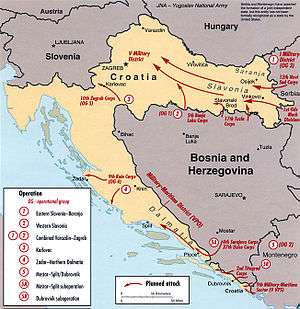
In March 1991, Yugoslav defense minister General Veljko Kadijević organized a meeting at the military complex in Topčider in Belgrade city. Present at this meeting were all 6 presidents of the Yugoslav republics, presidents of the autonomous republics, the Yugoslav president and all top military officers. Kadijević claimed that there were numerous paramilitary organizations in Yugoslavia sponsored by foreign and domestic enemies of the State. He also stated that the Yugoslav People's Army was dealing with Ustaše, Chetniks, and other enemies of socialism stemming from World War II conflicts. Kadijević proposed a declaration of martial law. A subsequent vote was held on Kadijević's recommendation of martial law, and the suggestion was vetoed.
In April 1991, the government of Croatia formed the Croatian National Guard (ZNG), which the Yugoslav People's Army considered to be a paramilitary organization.[15]
On 25 June 1991, Slovenia and Croatia declared their independence from Yugoslavia. On the same day Slovenian Territorial Defence units captured Yugoslav control posts on borders with Italy, Hungary, and Austria. Slovene forces also established border control posts on their border with Croatia.
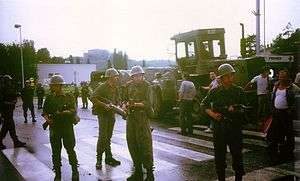
As a result of these actions, on 27 June 1991 the Yugoslav People's Army attacked; its top commanders citing the constitutional obligation to defend the sovereignty and territorial integrity of Yugoslavia. Yugoslav forces attacked the Slovene units on the border and in all other areas under Slovene control. The Slovenian Territorial Defence blockaded all ten Yugoslav bases in Slovenia and kept them under siege in a Ten-Day War which ended on 6 July 1991. Yugoslav forces suffered 44 killed and 146 wounded, with many Yugoslav officers wounded or captured. After the Brioni Agreement was signed, the Yugoslav People's Army agreed to withdraw from Slovenia by 10 October 1991, leaving numerous tanks, rifles, trucks and other equipment.
On 27 June 1991, war in Croatia began. The belligerents were the Yugoslav People's Army and Serbians on one side and Croatian military units on the other. On 14–15 September, Croatia launched the Battle of the Barracks, besieging over 20 Yugoslav People's Army barracks and depots, leaving Yugoslav soldiers without food, water or electricity for weeks. Some Croatian citizens deserted from the Yugoslav People's Army and began joining Croatian military forces. Senior Yugoslav officers also defected to the Croatia, including Air Force Commander-in-Chief Colonel general Anton Tus.
In August 1991, the Battle of Vukovar began. This was the biggest battle in the War in Croatia after operations Storm and Flash. In this battle 90% of the city was destroyed.[16] The Yugoslav People's Army used fighter and attack aircraft, rocket launchers, large number of tanks and other equipment.
Macedonia declared independence on 8 September 1991, but the Yugoslav People's Army did not militarily respond.
In November Vukovar was captured and 80% of Croatian forces were destroyed or captured. Many atrocities were committed in the city by the Yugoslav People's Army and local Serb volunteers, including the Velepromet concentration camp, Vukovar massacre, etc.
In mid-October 1991, Yugoslav ground forces, supported by naval and air forces, attacked the city of Dubrovnik and the Konavle area where Croats had strongholds, starting the Siege of Dubrovnik. By 6 December, Yugoslav forces had neutralized all Croat formations in the Konavle area, but Dubrovnik had not been captured.
After these two operations, the Yugoslav People's Army signed the Sarajevo Agreement with Croatia and began to withdraw.
In January 1992 Veljko Kadijević resigned after the 1992 European Community Monitor Mission helicopter downing.
The last Yugoslav soldier would leave Croatia in May 1992, when ships of the Yugoslav Navy sailed off Vis island to Kumbor in Montenegro.
The Yugoslav People's Army left Macedonia in March 1992. Macedonia was left without any heavy equipment, weapons or aircraft.
In March 1992 Bosnia and Herzegovina declared independence following a referendum and the Bosnian War started soon thereafter between the country's Bosniaks, Croats, and Serbs. The Yugoslav People's Army officially withdrew from Bosnia and Herzegovina in May 1992.
On 20 May 1992 the Yugoslav People's Army was formally dissolved, the remnants of which reformed into the military of the newly-founded "Federal Republic of Yugoslavia".
Peacekeeping operations

- United Nations Emergency Force (1956–1967) – 14,265 soldiers in 22 rotations, Colonel Lazar Mušicki as commander of mission (August 1964 – January 1965)
- United Nations Yemen Observation Mission (1963–1964) – one squad
- United Nations Iran–Iraq Military Observer Group (1988–1991) – military observers, General Slavko Jović as commander of mission
- United Nations Transition Assistance Group (1989–1990) – military observers
- United Nations Angola Verification Mission I (1989–1991) – military observers
Operational experience
- World War II in Yugoslavia
- Trieste crisis
- Yugoslav wars
- Ten-Day War in Slovenia (1991)
- Croatian War of Independence (1991)
- Bosnian War (1992)
See also
Militaries of the former Yugoslavia:
- Military of Bosnia-Herzegovina
- Military of Croatia
- Military of North Macedonia
- Military of Montenegro
- Military of Serbia
- Military of Slovenia
Notes
- Forsythe, David P. 2003. Central and South-Eastern Europe 2004. London: Europa Publications, p. 180
- Ramet, Sabrina P., & Danica Fink Hafner (eds.). 2006. Democratic Transition in Slovenia. College Station, TX: Texas A&M University Press, p. xiii
- p.202, Trifunovska
- http://mojustav.rs/wp-content/uploads/2013/04/Ustav-SFRJ-iz-1974.pdf
- http://scindeks.ceon.rs/article.aspx?artid=0042-84269105118S
- https://books.google.rs/books/about/Zakon_o_op%C5%A1tenarodnoj_odbrani.html?id=18d4PAAACAAJ&redir_esc=y
- https://hrcak.srce.hr/file/4445
- https://hrcak.srce.hr/file/4445
- https://hrcak.srce.hr/file/4445
- Lenard J. Cohen, Jasna Dragovic-Soso; (2007) State Collapse in South-Eastern Europe: New Perspectives on Yugoslavia's Disintegration p. 306; Purdue University Press, ISBN 1557534608
- Lenard J. Cohen, Jasna Dragovic-Soso; (2007) State Collapse in South-Eastern Europe: New Perspectives on Yugoslavia's Disintegration p. 306; Purdue University Press, ISBN 1557534608
- Lenard J. Cohen, Jasna Dragovic-Soso; (2007) State Collapse in South-Eastern Europe: New Perspectives on Yugoslavia's Disintegration (Aktuelle Analysen (May 11, 1991). Due to rounding, the total percentages might not be 100) p. 307,326; Purdue University Press, ISBN 1557534608
- Лексикон НОР 1980, p. 208.
- https://013info.rs/vesti/drustvo/preminuo-general-enes-taso
- Zimmerman, Warren (1 March 1995). "The Last Ambassador: A Memoir of the Collapse of Yugoslavia – Foreign Affairs". Foreign Affairs. Council on Foreign Relations, Inc. Archived from the original on 7 September 2015. Retrieved 7 September 2015.
The JNA was soon on a collision course with the breakaway republics. Both Croatia and Slovenia were trying to create their own military forces by calling on their young men to desert the JNA and by weakening the JNA's control over the republican Territorial Defense Forces, a sort of national guard. The JNA went berserk over this proliferation of armies. 'How many armies does the United States have?' Kadijević stormed at me.
- O'Shea 2005, p. 23
References
| Wikimedia Commons has media related to Yugoslav People's Army. |
- Trifunovska, Snezana, Yugoslavia Through Documents: From Its Creation to Its Dissolution, Martinus Nijhoff Publishers, 1994 ISBN 0-7923-2670-9
